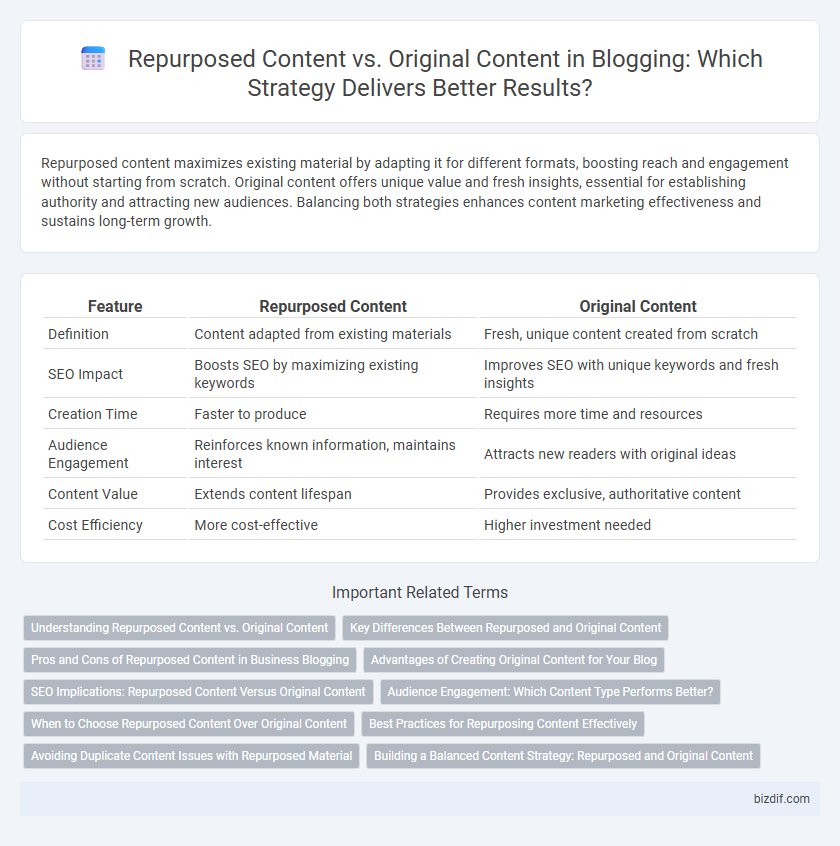Repurposed content maximizes existing material by adapting it for different formats, boosting reach and engagement without starting from scratch. Original content offers unique value and fresh insights, essential for establishing authority and attracting new audiences. Balancing both strategies enhances content marketing effectiveness and sustains long-term growth.
Table of Comparison
| Feature | Repurposed Content | Original Content |
|---|---|---|
| Definition | Content adapted from existing materials | Fresh, unique content created from scratch |
| SEO Impact | Boosts SEO by maximizing existing keywords | Improves SEO with unique keywords and fresh insights |
| Creation Time | Faster to produce | Requires more time and resources |
| Audience Engagement | Reinforces known information, maintains interest | Attracts new readers with original ideas |
| Content Value | Extends content lifespan | Provides exclusive, authoritative content |
| Cost Efficiency | More cost-effective | Higher investment needed |
Understanding Repurposed Content vs. Original Content
Repurposed content involves transforming existing material into new formats to extend its reach and lifespan, such as turning blog posts into videos or infographics. Original content is uniquely created from scratch, offering fresh ideas, authentic voice, and exclusive value that drive SEO and audience engagement. Balancing repurposed and original content enhances content marketing strategies by maximizing resource efficiency while maintaining creativity and authority.
Key Differences Between Repurposed and Original Content
Repurposed content transforms existing materials into new formats, enhancing reach and efficiency by targeting different audience segments without extensive resource expenditure. Original content involves creating unique and fresh material, driving SEO value and establishing authority through originality and depth. Key differences lie in creation effort, SEO impact, and the ability to deliver novel insights versus maximizing previous content investments.
Pros and Cons of Repurposed Content in Business Blogging
Repurposed content in business blogging enhances SEO by leveraging existing material to increase reach and engagement without the need for constant creation, saving time and resources. However, relying heavily on repurposed content may lead to diminished originality, potentially reducing brand authority and reader trust. Striking a balance ensures sustained audience interest while maximizing content marketing efficiency and value.
Advantages of Creating Original Content for Your Blog
Original content enhances your blog's SEO performance by providing unique, keyword-rich material that search engines prioritize. It establishes your authority and credibility in your niche, attracting a loyal audience and increasing engagement. Creating original content also fosters brand identity, differentiating your blog from competitors who rely on repurposed material.
SEO Implications: Repurposed Content Versus Original Content
Repurposed content enhances SEO by expanding keyword reach and improving content lifespan, while original content drives unique search rankings and authoritative domain trust. Search engines favor fresh, original content for higher ranking but reward repurposed material when it effectively targets varied user intents with relevant keywords. Balancing repurposed and original content strategies maximizes organic traffic by leveraging both novelty and optimized keyword diversification.
Audience Engagement: Which Content Type Performs Better?
Original content typically drives higher audience engagement due to its uniqueness and ability to address specific audience needs, fostering trust and loyalty. Repurposed content can sustain engagement by reaching broader audiences through varied formats but may lack the freshness that attracts repeat visitors. Data from content marketing studies show that blogs featuring original insights achieve up to 70% more shares and comments compared to repurposed posts.
When to Choose Repurposed Content Over Original Content
Repurposed content is ideal when time constraints or limited resources hinder the production of original material, allowing bloggers to maximize existing content's value. It effectively targets different audience segments by adapting formats such as turning blog posts into videos or infographics, boosting engagement across platforms. Choosing repurposed content over original content also helps maintain consistent publication schedules and reinforces core messages without the need for complete content creation.
Best Practices for Repurposing Content Effectively
Repurposing content effectively involves identifying high-performing original content and adapting it to new formats such as videos, infographics, or social media posts to maximize reach and engagement. Using keyword research ensures repurposed content aligns with current SEO trends, boosting organic traffic and visibility. Maintaining the core message while tailoring the presentation to different audience preferences enhances content longevity and brand authority.
Avoiding Duplicate Content Issues with Repurposed Material
Repurposed content offers a strategic advantage by transforming existing material into new formats, reducing the risk of duplicate content penalties when properly optimized. Implementing canonical tags, updating metadata, and adding unique insights or visuals ensures search engines recognize repurposed content as valuable and distinct. Maintaining a balance between original and repurposed content enhances SEO performance while preserving originality and avoiding algorithmic penalties.
Building a Balanced Content Strategy: Repurposed and Original Content
Building a balanced content strategy involves integrating repurposed content with original content to maximize reach and engagement. Repurposed content leverages existing materials, such as blog posts, videos, or podcasts, reshaped for different formats to attract new audiences with less effort. Original content fuels brand authority and SEO by offering fresh insights and unique value, ensuring continuous audience growth and improved search rankings.
Repurposed content vs Original content Infographic

 bizdif.com
bizdif.com